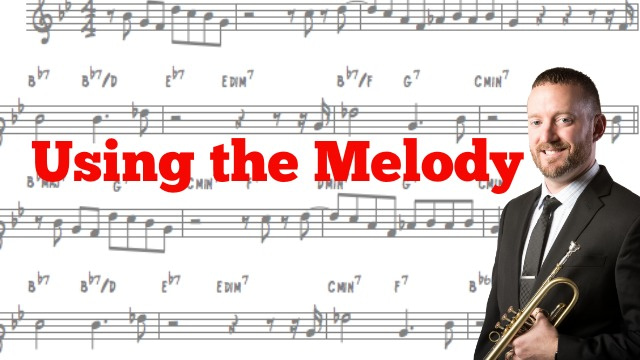Phrasing Exercise
Last week’s post was on the importance of targeting the end of the phrase and it reminded me of a fun and challenging exercise I use to make sure I’ve got the end of the phrase at the front of my mind. I wanted to share that exercise with all of you in this week’s post. If this is your first time visiting the site-welcome! If you’re curious to know how I came up with the note choices in the examples below-check out my Digital Store where you can get more information on two improv books I’ve written that will help!
This is a very simple exercise to describe, but one that can be challenging as well. Remember that this is an exercise and not how you should improvise on the bandstand (although you can use it if you so choose).
- The end of your phrase (or idea) becomes the first note of your next phrase. You can change the first note of the next phrase as much as a whole step away to create variety. This continues through the entire chord progression.
Sounds simple, right? However, thinking about it and doing it are two different things. The further along the song’s progression the more difficult it becomes because it forces you to think ahead and not always start your phrases the same way (i.e. always starting on the 3rd of a chord). Let’s take a look at some examples. Below is our first phrase with the last note circled.
We know that the “G” is our last note of the phrase. Depending on what the chord progression would be next determines whether we start on the same note “G” or if we need to move a half-step or whole-step away. Let’s take a look at an example that shows the first phrase going into a second while keeping the “G.”
The final example shows the first phrase going into a second phrase where we altered the starting note by a half-step.
It’s a simple, challenging and fun exercise that will help you on multiple levels. When you learn a new song/progression I would suggest you do this exercise over the changes as well. I hope you’ve found this tip beneficial and that it adds value to you (and your students) playing!






I really like these application-type blog posts of targeting. I’d like to see more about how to connect them together over a variety of chord progressions (chords moving in fourths, 3rds, 2nds, etc) as well as different chord types. Specifically going from the previous target to the next target in cases when randomly combining approaches to various chord tones doesn’t quite work, or for balance – combining chromatic approaches with arpeggios, pentatonics. Your 3 etudes are a great help, maybe do them over a variety of standards and multiple choruses.
Hey Will
I believe targeting (which is more then just chromatic) works well over all types of progressions. Many of the examples I use on the site are ii-V-I’s for the sake of showing the concept. In Targeting: Improvisation With Purpose there are a few different examples of combining chromatic targeting with pentatonics as well as other tools that are covered in the book. There’s also another topic I posted under the Etudes category about the benefits of writing your own. I encourage students to find ways to build some of these concepts into an etude which, when practiced over time, eventually shows up in your improvisations. Also, if you haven’t checked out Breaking the Monotony yet, there are more etudes that combine the rhythmic concepts I use along with targeting. If I get some time I’ll maybe post a new etude over a standard.
All the best,
Jason
Thanks. I started writing etudes recently after noticing that a lot of what I practice doesn’t seem to get into my playing, even transcribing and learning solos doesn’t seem to do it. So I continue to search for the missing link as to how to get concepts absorbed into my playing, versus a ‘deer in the headlights’ feeling when it comes time to improvise over a standard. What happens during composition is what I would call ‘problem areas’ or challenges – chords that aren’t part of a ii-V-I, multiple chords per bar, different chord movements (down/up seconds, thirds, etc), diminished chords. The concept is the same but putting a solo together that sounds good takes some work, and then I guess you hope this work comes out in your playing down the road. I’m also reworking on hearing chord tones and voice leading lines. Thanks again.
I hear you. It does take some time to for it to translate over to your playing. Start with tools that your ear gravitates the most to and apply them first. Sing them and if you come up with a new deviation from the original…transcribe it and use it. I talk about that in a topic on transcribing yourself. I find that moves the whole process along faster.
As far as the composition challenges it might help to think of a measure/bar as two separate parts. The first half as the resolution and the second half as the tension. The tension sets up the resolution. The tools we use are the tension piece. The resolution part is either the chord tone we’re aiming for or it is a continuation of tension to an eventual resolution. Mix in some space so the overall arc of the composition breathes and you will find a more pleasing line. That’s the beauty of writing etudes…if it doesn’t work out you can re-write it until it does.